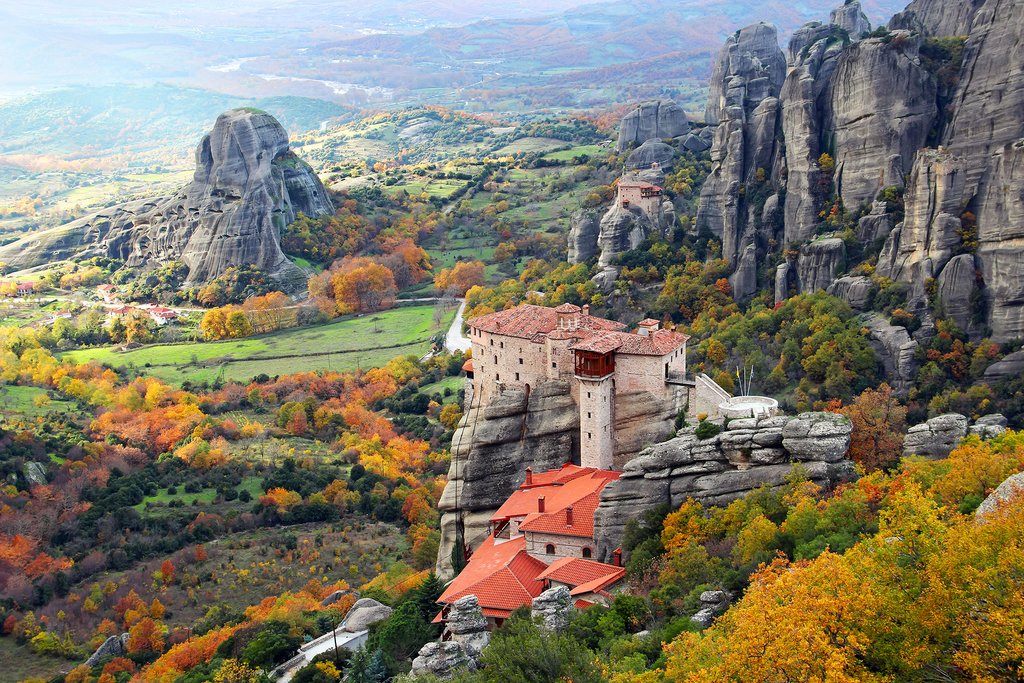
Greece has a Mediterranean climate with four seasons and a long, dry summer. There’s never a bad time to visit the country, but depending on how hot you like it, the most pleasant temperatures are in spring (March to May) and fall (mid-September to November). But no matter the time of year, there’s always a reason to go.
## Discovering the Allure of Greece: A Seasonal Guide
Greece, a land steeped in ancient history and blessed with stunning natural beauty, beckons travelers year-round with its unique charm and diverse offerings. Deciding when to visit this Mediterranean paradise depends on your priorities, whether you seek tranquil exploration, vibrant festivities, or adventurous pursuits.
**When is the opportune moment to embark on your Greek adventure?**
Winter, often perceived as a quiet period in Greece, holds a distinct appeal for those seeking solitude and introspection. Imagine exploring majestic historical sites such as **Delphi** with minimal crowds, allowing for a truly immersive experience. Furthermore, embrace the local spirit by indulging in winter sports on the legendary **Mount Olympus**, a unique opportunity to combine cultural immersion with outdoor recreation. Summer, on the other hand, represents the zenith of tourist activity, characterized by higher prices for accommodations and excursions. However, this season also boasts uninterrupted sunshine, facilitating effortless island hopping via frequent ferry services. The lively tavernas, buzzing with energy, provide an authentic taste of Greek nightlife and culinary delights. The shoulder seasons of spring and fall offer a delightful compromise, with the Mediterranean climate bestowing balmy temperatures that make every visitor feel like a Greek god or goddess.
## Spring (March to May): A Season of Rebirth and Renewal

While March may bring occasional showers and cooler temperatures, the period from late April to May is widely regarded as an ideal time to explore Greece. During these months, hotel rates tend to be more affordable, the weather is predominantly warm and sunny, and the landscape transforms into a vibrant tapestry of wildflowers. Hiking enthusiasts will find themselves captivated by the numerous mountain trails that crisscross the country, which covers over 80% of the territory. Spring in Greece is a fleeting yet enchanting season, with May often mirroring the characteristics of summer. By the end of May, the sea becomes inviting for swimming, offering a refreshing respite from the warming temperatures. A multitude of activities await during this time, catering to diverse interests and preferences.
If your travel dates coincide with Orthodox Easter, consider establishing a base in one location. This significant holiday prompts widespread travel among locals returning home to celebrate with their families, resulting in busier roads and temporary closures of banks. However, it also presents a unique opportunity to witness authentic cultural traditions and immerse yourself in the local way of life. Experienced travel specialists can curate unique cultural experiences that will enrich your visit and create lasting memories.
## Summer (June to August): Bask in the Mediterranean Sun

Summer’s popularity as the peak season in Greece is well-deserved. The crystal-clear waters are perfect for swimming, every hotel, restaurant, and ferry service operates at full capacity, the days are bathed in sunshine, and rainfall is virtually nonexistent. On the Greek islands, the refreshing north winds provide a welcome relief from the heat, particularly in the evenings, which are often delightfully mild.
In bustling urban centers like **Athens** and **Thessaloniki**, daytime temperatures can soar to uncomfortable levels. Therefore, if you plan to visit during the high season, it is advisable to schedule your sightseeing activities for the cooler early morning or late evening hours. August marks the traditional vacation period for many Greeks residing in major cities, who typically escape to the coast to escape the intense heat, as temperatures frequently exceed 100°F (38°C).
Travelers visiting between mid-June and September, when European schools are on summer break, should book accommodations and activities well in advance to secure their preferred choices. Unless you have specific culinary experiences in mind, advance restaurant reservations are generally not required.
For those seeking respite from the crowds and heat, the higher elevations offer cooler temperatures and a more tranquil atmosphere. Hiking and cycling enthusiasts can explore scenic trails and enjoy breathtaking views during the high season. Consider venturing onto the **Menalon Trail**, a 47-mile path that winds through the mountains of the **Peloponnese** region, providing an unforgettable adventure.
## Fall (September to November): A Symphony of Colors and Serenity

The period from mid-September to mid-October presents a compelling opportunity to experience Greece with fewer crowds and pleasant sunny weather. The average fall temperature is typically warmer than in spring, and swimming along the coast remains enjoyable until mid-October. Additionally, hotel prices often decrease after the summer season, making it a more budget-friendly time to visit.
By late October, many ferry companies suspend their operations, and hotels and tavernas begin to close in preparation for the winter months. November is characterized by a mix of sunny days and cooler, overcast weather.
Autumn is an exceptional time to explore **Athens**. The cooler temperatures, the changing colors of the foliage, and the possibility of experiencing the **Acropolis** in relative solitude make it an unforgettable experience. Consider embarking on a four-day itinerary dedicated to exploring the highlights of **Athens**, or incorporate it as a stop on a more extensive journey through Greece.
## Winter (December to February): Discover a Different Side of Greece

Greek winters are generally milder compared to other parts of Europe. Southern Greece often maintains an autumnal atmosphere until mid-December. January and February are the coldest months, characterized by increased rainfall throughout the season.
During the winter, visitors can join locals for skiing in the Greek mountains. **Mount Parnassus**, situated approximately two hours from **Athens**, boasts four of the country’s largest ski resorts. While these resorts may not match the scale of those in the Alps, they offer fewer crowds and lower prices. Furthermore, a side trip to the ancient ruins of **Delphi** can easily be incorporated into your itinerary. Skiing is also possible on **Mount Olympus** at the **Elatochori Ski Center**.
The farther south you travel in Greece during winter, the milder the climate becomes. **Crete**, the largest and southernmost of the Greek islands, is an excellent winter destination. While sunbathing opportunities may be limited, visitors can explore Minoan strongholds such as **Knossos** in relative peace and quiet. Numerous local cultural events take place during this time of year. **Santorini** is another appealing option, as many hotels and restaurants remain open throughout the winter months. However, on smaller islands, many accommodations and restaurants close for the season, and ferry and flight services are reduced across the country.
B-1066

